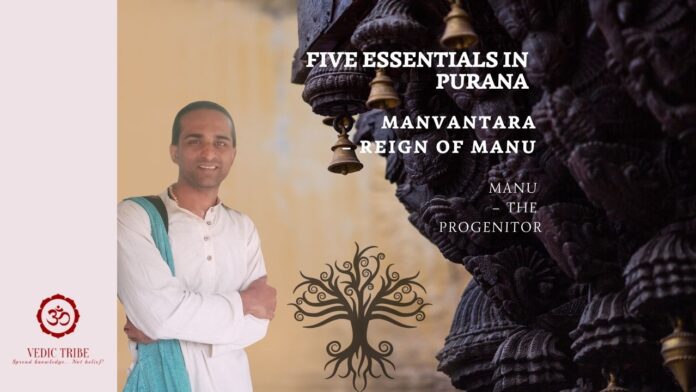Manu – the progenitor:
In the previous article we discussed the common thread among Purana – “Vamsha” (lineage) and in this article, we will discuss the common thread – “Manvantara” (Reign of Manu).
The concept of Manvantaras provides a framework for understanding the vastness of cosmic time and the cyclical nature of existence as described in Puranic cosmology. It highlights the role of Manus as progenitors of humanity and guides for their spiritual and social development.
Due to the prominence of the Manu Smriti, the term “Manu” gradually came to be primarily associated with the author of this text. This led to a narrower understanding of the term, overshadowing its original significance as a progenitor of humanity during a specific Manvantara.
In Puranic cosmology, “Manu” represents a progenitor of humanity during a specific Manvantara (cosmic epoch). Each Manvantara is ruled by a different Manu, who is responsible for establishing social order, laws, and religious practices during their reign.
Manvantara – a small segment in vast cosmic timeline:
Puranic cosmology emphasizes the cyclical nature of creation and dissolution. The universe undergoes periodic cycles of creation, maintenance, and destruction. “Virinchi” or Brahma is responsible for the creation and sustenance of the universe during each cosmic cycle.
Kalpa: A Kalpa is a vast period of time, equivalent to one day and night of Brahma (roughly 4.32 billion years)
Manvantara: Within each Kalpa, there are fourteen Manvantaras, each ruled by a different Manu. (roughly 306 million years each)
Current Era:
Shweta Varaha Kalpa: We are currently in the Shweta Varaha Kalpa, which is the first day of the second half of Brahma’s lifespan.
Vyvasvata Manvantara: The current Manvantara is the seventh, ruled by Vyvasvata Manu, the son of Surya.
Chatur-Yuga Cycles: Within each Manvantara, the cycle of four Yugas (Satya Yuga, Treta Yuga, Dwapara Yuga, and Kali Yuga) repeats 71 times.
Current Kali Yuga: We are currently in the 28th cycle of the four Yugas within the Vyvasvata Manvantara.
Significance of Manvantaras:
Cosmic Cycles: The concept of Manvantaras underscores the cyclical nature of time and the universe. It highlights the vastness of cosmic time and the recurring patterns of creation and dissolution.
Rulers of Humanity: Each Manu is considered a progenitor of humanity during their respective Manvantara. They are responsible for establishing social order, laws, and religious practices during their reign.
Evolution of Consciousness: Each Manvantara can be seen as a period of evolution for sentient beings, with each Manu guiding them through a specific stage of its development.
Departure from Other Mythologies:
The concept of Manvantaras with distinct rulers and cyclical epochs is a unique feature of Puranic cosmology.
Many other creation myths do not incorporate such elaborate systems of cosmic time and the succession of rulers over vast periods.
Remember:
– We must understand that Puranic cosmology presents the concept of Manvantaras to illustrate the immense scale of cosmic time and the cyclical nature of existence.
– This framework also emphasizes the dynamic role of consciousness across various levels, with Manu presented as a guiding force for spiritual and social evolution.
– We must remember Vaivasvatha Manu in our daily prayer and seek blessings for our spiritual growth.
In Conclusion:
The idea of Manvantaras offers a context for discerning the massiveness of cosmic timelines and the cyclical nature of it. It helps us to surrender to the higher divine beings operating the cyclical cosmos and connect with them at a spiritual level.
In our next article, we will discuss the common thread among Purana – “Vamsanucharita”
Madhwesh K
Vedic Tribe

